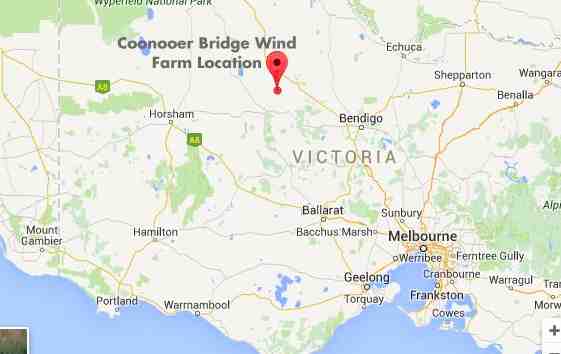Construction officially began on Friday on a wind farm that will be the lowest cost wind farm in Australia, the first commercial project to have direct ownership from community members, and also the first new facility to get the go-ahead and begin construction since the election of the Abbott government in late 2013.
The 19.8MW Coonooer Bridge wind farm, about 80kms north west of Bendigo in Victoria, is expected to be completed early next year, and is the first of three wind farms that will be built thanks to the 90 per cent renewable energy target from the ACT government.
Coonooer Bridge will receive a tariff of $81.50/MWh from the ACT. Not only is this believed to be the lowest contracted price in Australia (although most contracts are private) it will remain fixed for 20 years, with no indexing for inflation.
The $50 million wind farm is being built by Windlab, which has based its operations in Canberra and currently employs 15 people, but expects this to grow significantly in coming years. The direct ownership by the community is only small, but a first in Australia for a commercial wind farm. Japan’s Eurus will own 80 per cent of the facility.
ACT minister for the environment Simon Corbell said the result proved the success of the reverse auctions held by his government.
“Wind is currently the lowest-cost renewable energy generation available, and will play a big role in the decarbonisation of the ACTs electricity supply,” Corbell said. “It will contribute approximately three-quarters of the ACT’s 90 per cent renewable energy target.”
While the Abbott government can take no credit for the construction of Coonooer Bridge, the fact that the renewable energy target finally has bipartisan support, albeit at a much reduced target of 33,000GWh, means that the ACT is reviewing the timing of its next round of wind auctions.
“There is going to be an increase in activity, and a significantt opportunity for low cost projects,”Corbell told RenewEconomy ahead of the ceremony. “We will certaintly be looking at our options and what that means for the ACT strategy.”
Although Corbell would not be specific, the assumption would be that the ACT government would bring those auctions forward. There is a possibility of another 200MW of auctions, along with 50MW of next generation solar (with storage) that will be decided within a few months.
Expressions of interest for the solar plus storage scheme (which may include PV plus storage or solar thermal with storage) are due to be filed next week, after which Corbell’s team will decide whether to hold an auction, or direct negotiations with a project that may be well advanced over rivals.
Corbell welcomed the certainty provided by the RET legislation passage, but warned that it may not be permanent, given the Abbott government’s clear preference not to build wind farms.
“My attitude is that the certainty is welcome, but it is only a short to medium term comment,” he said. “The comments by the PM suggest that if there was scope to re-negotiate that would be on the table.
“That concerns me deeply. Australia’s international obligations will require a much higher ambition for decarbonation of electricity sector. We are going to need a higher level of ambition, not a lower level of ambition.”
It is important to note, however, that while Coonooer Bridge is the lowest cost wind farm in Australia, wind energy costs in Australia are more than double that of other countries, such as the US, because of the lack of local manufacturing and the high cost of labour and finance. Only the towers are being constructed in Australia.
The Coonooer Bridge wind farm will feature six 3,3MW turbines made by Vestas. The turbine towers will be built by Portland-based manufacturing company Keppel Prince Engineering, whose general manager Steve Garner said the project was a “lifeline” for the company’s tower manufacturing division, which was forced to lay off 100 people last year as a result of the investment drought caused by the Abbott government’s review of the RET.
The Coonooer Bridge project is expected to be the first of around 35 projects to be built to meet the revised RET, although many analysts, and some large utilities, now expect large solar plants to make up a significant part of the capacity built to meet the target.











